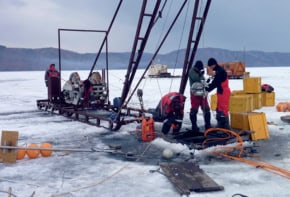Atomic: The First War of Physics and the Secret History of the Atom Bomb: 1939–49
Jim Baggott
2009 Icon Books
£10.99 pb 576pp

There is no shortage of popular histories of the creation of nuclear weapons. From the mid-1940s to the present day, scientists, historians and others have tried to explain the genesis of these awesome and awful weapons, and the reasons for their use against Japan at the end of the Second World War. From the official 1945 Smyth Report on the Manhattan Project to Richard Rhodes’ 1986 Pulitzer Prize-winning The Making of the Atomic Bomb and beyond, the history of nuclear weapons and the Cold War continues to exert a powerful and sometimes macabre fascination for those interested in the history of modern science.
Secrecy has always been part of the allure of nuclear technology. One reason for a recent proliferation of nuclear histories has been the gradual release of new archival documentation, particularly from the former Soviet Union and Eastern Europe. British Cold War archives (including selected MI5 files) have also become more accessible in recent years following the advent of “open government” and the Freedom of Information Act. Historians have been busy in these archives for two decades, with results that include Mark Walker’s superb work on the Nazi atomic-bomb project, David Holloway’s on the Soviet Union, and ongoing efforts of military, diplomatic and science historians to elucidate the reasons for the Hiroshima and Nagasaki bombings. These histories – and many more – have transformed our understanding of the early history of the nuclear age.
But one consequence of these excellent, specialized histories is that there is now a place, even in such a crowded field, for a book that brings some of this fresh information together into a good, accessible general history. With Atomic, Jim Baggott, a business consultant and popular-science writer, may well have written it. His book draws on reams of more specialized scholarship to produce a well-informed and highly readable overview of early nuclear history.
A bit of a brick at nearly 600 pages, the book is divided into four sections. It covers the mobilization of physicists at the outbreak of war and the initial wartime nuclear programmes in Britain, America and Germany; the subsequent development of these programmes and the creation of ENORMOZ, the Soviet espionage operation against the Manhattan Project; the demise of the Nazi bomb project and the development and denouement of the Allied one; and the way in which these events played out at the beginning of the Cold War, concluding with the first Soviet nuclear test in 1949.
All the familiar names of nuclear history are here – Heisenberg, Bohr, Chadwick, Oppenheimer, Fermi, Lawrence, Frisch, Peierls (see pp38–39), Teller, Kurchatov and the rest – and many other less well-known figures. Linking the various episodes are two interweaving themes: the story of the Allies’ attempts to destroy a heavy-water factory in Nazi-controlled Norway; and the role of spies, espionage and counter-espionage in the transfer of nuclear information from country to country in the 1940s and 1950s. Indeed, through his accounts of Klaus Fuchs and the other atomic spies, one of Baggott’s neatest accomplishments is to show clearly how secrecy and spying both permeated the wartime nuclear projects and shaped the ensuing Cold War, and national and international politics.
The author does an excellent job both of describing the various parallel national programmes and of integrating the scientific, technical, political, strategic, special operations and espionage elements on the larger international stage. His account is dramatic, pacey and engaging, and manages to convey a rich sense both of the various personalities involved and of the larger forces that shaped the events. He mostly manages to resist sensationalizing the material, though his journalistic tendency to end each subsection with a punchy, prophetic sentence does occasionally grate. A comparative timeline of the various national developments and a listing of the key dramatis personae with brief biographical details form very useful appendices.
The book is significantly weaker on the uses and consequences of the first nuclear weapons and their role in the early Cold War. Here Baggott misses a substantial literature from political and diplomatic historians who have been exploring the myths and realities around the “half a million lives saved” by the bombings of Hiroshima and Nagasaki, and the idea of “atomic diplomacy.” Elsewhere, he is perhaps too ready to take his sources at face value, and tends to offer simplistic judgements (for example about the clichéd “Faustian” pact between physicists and the military) that do not reflect the complex historical debates currently taking place about much of this material. Similarly, an overlong “epilogue” takes the story from 1950 through the Oppenheimer trial of 1954 and the Cuban Missile Crisis in 1962 and into the 21st century, but draws on a far too narrow a source base, making for a rather patchy and untidy end to the narrative.
Despite these criticisms, Atomic is now one of the most accessible synthetic and up-to-date histories of the early nuclear age. The book will be useful as a broad introduction to the history of nuclear weapons in their wider context – though interested readers may well wish to progress quickly to the more nuanced historical accounts from which Baggott draws.



